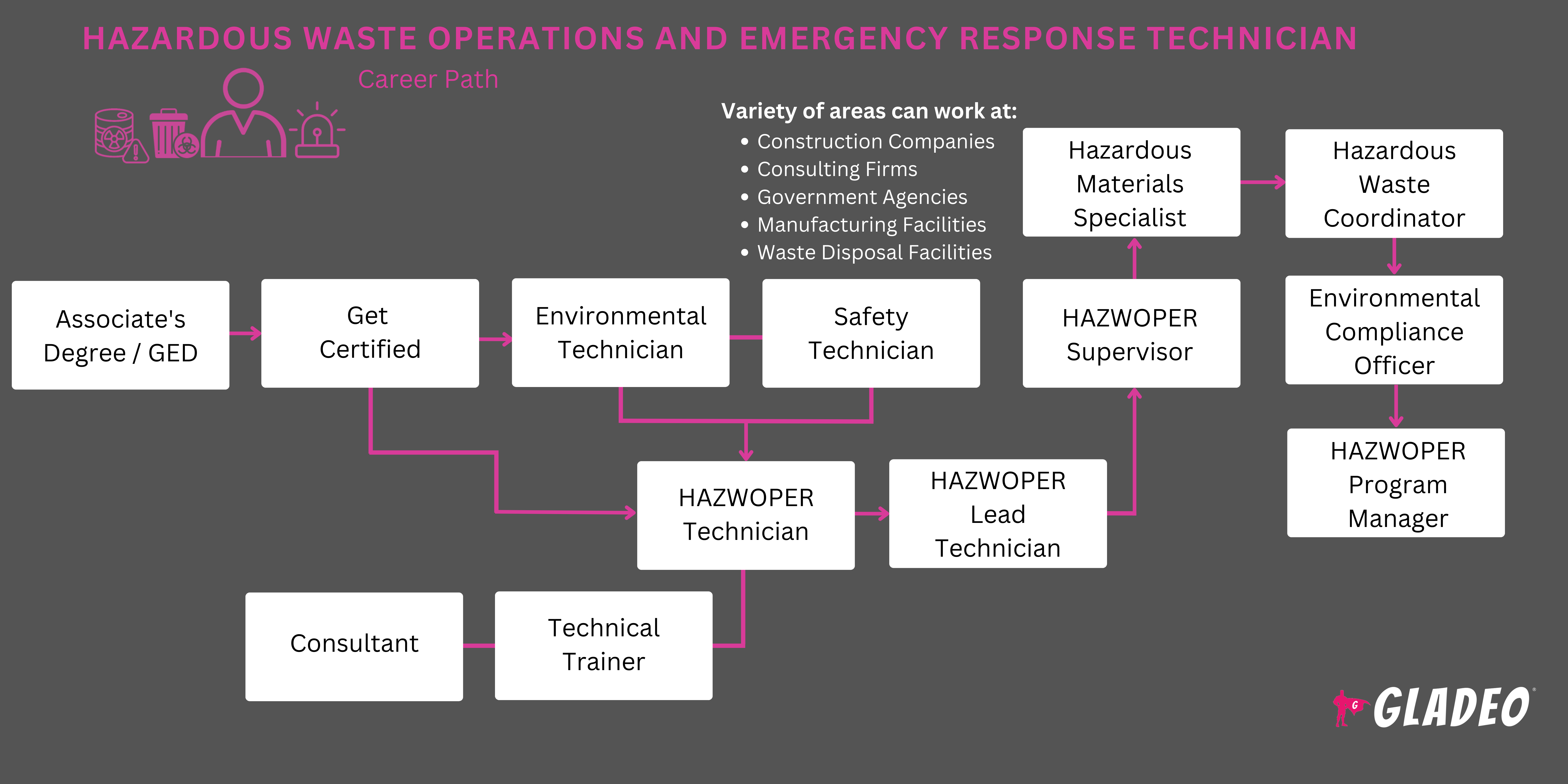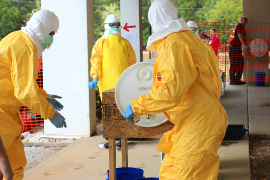Mga spotlight
Technician ng Mapanganib na Materyales, Technician ng Mapanganib na Basura, Espesyalista sa Mapanganib na Materyales, Technician ng Pagtugon sa Mapanganib na Materyales, Technician sa Pagwawasto sa Kapaligiran, Espesyalista sa Paglilinis ng Kapaligiran, Technician sa Pagtugon sa Pagtugon ng Chemical Spill
Humans have a knack for creating dangerous substances! From toxic chemicals and corrosives to medical waste, flammable materials, and explosives, the world produces about 400 million tons of hazardous materials every year. That’s about the same weight as a million Empire State Buildings!
Hazardous waste can be produced during the manufacturing of chemicals, petroleum, coal products, pesticides, fertilizer, iron, and steel. It also comes from waste treatment and disposal, radioactive elements, lead, asbestos, radon gas, arsenic, mercury—the list goes on.
With so many occurrences of hazardous materials, we need experts who know how to safely handle them. That’s where Hazardous Waste Operations and Emergency Response Technicians (or HAZWOPERs) come in!
These specially-trained pros make sure dangerous substances don’t jeopardize workers, communities, wildlife, and the environment. HAZWOPERs are also called out to respond to incidents and emergencies, where they can help clean up waste sites, manage spills, and contain or neutralize toxic materials!
- Safely manage and mitigate hazardous material incidents
- Protect the public, wildlife, and the environment from hazardous substances
- Acquire valuable skills in emergency response and hazardous waste management
Oras ng trabaho
HAZWOPERs work full time with overtime common due to emergencies or other incident response.
Mga Karaniwang Tungkulin
- Respond to routine and emergency hazardous material incidents. Assess hazardous situations
- When applicable, measure or test the hazard level posed by materials (such as radiation levels) using monitoring devices
- Plan and execute procedures for safely managing and cleaning up hazardous materials
- Work on teams to prevent exposure/contamination during emergency responses or waste operations
- Prepare containment areas before starting work
- Neutralize hazardous substances as needed before cleanup
- Identify and wear the proper personal protective equipment for the situation (i.e., bodysuits, gloves, face shields, breathing apparatus, etc.)
- Potentially work in confined spaces, at heights, or in inclement weather
- Use detergents, chemicals, and/or tools to remove harmful materials from affected surfaces
- Operate machines or vehicles to assist with cleaning, disposal, and transport
- Mix concrete to encase waste that will be disposed of, as needed
- Utilize bioremediation practices on substances that bacteria can safely break down
- Pack, load, transport, or store waste. Follow strict hazardous waste disposal methods and laws
- Label and track waste to be removed. Maintain documentation and records of where materials are moved
- Sort at landfills or other sites, as directed; separate waste that could be recycled
Karagdagang Pananagutan
- Keep up-to-date on hazardous materials handling procedures and regulations
- Comply with organizational, state, and federal policies or regulations regarding safety, ethical, and legal requirements
- Examples of federal agencies include the Environmental Protection
Agency and Occupational Safety and Health Administration
- Work closely with team leaders and members to ensure the overall job and all tasks are carried out safely and properly
Soft Skills
- Aktibong pakikinig
- Nakatuon sa pagsunod
- Koordinasyon
- Kritikal na pag-iisip
- Mabusisi pagdating sa detalye
- Pagsubaybay
- pasensya
- Pagpaplano at organisasyon
- Mga kasanayan sa paglutas ng problema
- Maingat sa kaligtasan
- Malakas na kasanayan sa komunikasyon
- Mukhang makatarungan
- Pagtutulungan ng magkakasama
- Pamamahala ng oras
Teknikal na kasanayan
- Familiarity with chemicals including solvents and cleaners
- Operation of hoists, forklifts, cranes, or trucks and bobcats (if needed)
- Physical strength and stamina.
- Safety and emergency response protocols (such as using emergency showers and eyewash stations)
- Safe use of hand and power tools, such as vacuums, sandblasters, high-pressure sprayers, etc.)
- Use of appropriate personal protective equipment and related gear
- Use of hazardous material monitoring equipment
- Pangunang lunas/CPR
- Incident Command System
- National Incident Management System
- OSHA lockout/tagout
- Confined space entry and rescue
- Knowledge of the Resource Conservation and Recovery Act
- Chemical plants
- Construction sites
- Emergency response service providers
- Mga ahensya ng gobyerno at kapaligiran
- Hazardous waste treatment, storage, and disposal facilities
Laboratories - Manufacturing facilities
- Mga operasyon sa pagmimina
- Oil spill cleanup sites
- Mga pribadong kontratista
- Mga serbisyo sa remediation at pamamahala ng basura
- Superfund sites
Over the decades, there have been numerous environmental disasters involving toxic substances which affected the health and lives of hundreds or even thousands of people. In some cases, exposure can be so bad that it makes an area uninhabitable for years.
That’s why Hazardous Materials Removal Workers are very important jobs, which can involve responding to situations quickly. Shifts can run long when there’s a big, urgent job, and sometimes workers will try to take shortcuts during cleanup efforts. HAZWOPER Technicians, however, must take their time and ensure the job is done right, not only for safety reasons but also because violations can lead to expensive fines.
Obviously, hazardous waste is dangerous, so they also have to follow safety rules closely to avoid personal risk. They’re also expected to neutralize and clean all affected surfaces swiftly and effectively, so waste doesn’t impact other workers, the local community, nearby wildlife, or the environment in general.
The safe removal of hazardous material is a priority for the Environmental Protection Agency, OSHA, and many other governmental organizations. It’s also a matter of significance to private companies which can be hit with citations and massive fines for failing to comply with proper waste disposal rules.
For example, in 2023, chemical manufacturer 3M was ordered to pay “$10.3 billion to settle lawsuits over contamination of many U.S. public drinking water systems with potentially harmful compounds.”
In 2021, the State of California sued Walmart for “illegal disposal of hazardous waste” such as “alkaline and lithium batteries, insect killer sprays and other pesticides, aerosol cans, toxic cleaning supplies, electronic waste, latex paints, and LED light bulbs” dumped in landfills.
Clearly, the pressure is on companies to strictly comply with state and federal regulations designed to protect workers, the public, the environment, and wildlife.
Hazardous Materials Removal Workers may have enjoyed being outdoors or engaged in physical activities when they were younger. They may have also liked working as part of a team striving toward a common goal such as in sports.
- Hazardous Materials Removal Workers must be at least 18 and have a high school diploma or GED
- Workers don’t need a college degree but must complete a training course based on OSHA standards
- Employers determine the appropriate number of training hours (usually at least 40) covering:
- Site Safety and Health Personnel
- Hazards Identification
- Personal Protective Equipment
- Minimizing Risk Work Practices
- Safe Use of Controls and Equipment
- Medical Surveillance
- Safety and Health Plan Contents
- Training programs must meet OSHA’s HAZWOPER standards. Many classes can be done online, but some might require a practical, hands-on component
- Additional training is needed for respirator wear, nuclear materials, OSHA lockout/tagout, confined space entry and rescue, and other special areas
- Managers and supervisors must also complete extra training
- Related work experience, such as in construction, may help HAZWOPERs learn faster
- Ang mga permit o lisensya na ibinigay ng estado ay kinakailangan para magtrabaho o magdala ng ilang mga basurang materyales, gaya ng asbestos at tingga. Ang mga permit/lisensya na ito ay karaniwang nangangailangan ng pagpasa sa pagsusulit at pagkuha ng mga nagpapatuloy na klase
- Workers may need to learn how to operate hoists, forklifts, cranes, or trucks. Training is usually provided
- HAZWOPERs use various hand and power tools, such as vacuums, sandblasters, high-pressure sprayers, etc. Training is usually provided
- Pangunang lunas/CPR
- Some positions may require knowledge of the Incident Command System and National Incident Management System
- Kasama sa mga opsyonal na sertipikasyon ang:
- Federal Motor Carrier Safety Administration - Hazardous Material Endorsement
- Institute of Hazardous Materials Management - Certified Hazardous Materials Practitioner
- International Board for Certification of Safety Managers - Certified Hazard Control Manager
- HAZWOPERs don’t need a college degree. Training is often provided by employers and through applicable governmental agencies, as needed. However, students can sign up for courses in hazardous materials management and waste technology at a community college or vocational/trade school if they want to pursue a certificate or associate degree. Courses and programs should meet OSHA requirements.
- Those who want to qualify for higher-level positions may earn a bachelor’s in hazmat management or environmental science later.
- Magbayad ng pansin sa mga klase sa matematika at chemistry sa high school, at magboluntaryo para sa mga aktibidad ng mag-aaral kung saan matututo ka tungkol sa pagtutulungan ng magkakasama at pamamahala ng proyekto
- Take shop classes to get used to working with hand and power tools or snag a part-time job in construction
- Volunteer for construction projects in your community, such as with Habitat for Humanity
- Engage in a physical exercise program to develop the strength and stamina needed for this job
- Learn the various types of hazmat environments and career options. Try to decide which area you want to work in
- Review job postings and look for opportunities in your area that provide training
- Consider going a Hazardous Materials Removal Workers apprenticeship
- Kung kinakailangan, i-knock out ang ilang mga klase na may kaugnayan sa hazmat o isang sertipiko sa isang vocational school o community college para makatulong na palakasin ang iyong mga kredensyal
- Maaaring kailanganin ng mga manggagawa na magkaroon ng wastong lisensya sa pagmamaneho, kaya kung wala ka nito, maaari kang mag-aral at kumuha ng pagsusulit upang makakuha ng lisensya

- Employers may provide all training necessary, but some want workers with prior experience or specialized certifications
- Get practical work experience under your belt before applying, if possible. Jobs related to construction, cleaning, or working with tools and equipment will look good on an application!
- Maghanap ng mga pagkakataon sa apprenticeship na may kaugnayan sa hazmat o construction
- Check out job portals such as Indeed, Simply Hired, and Glassdoor, as well as Craigslist or the career pages of organizations you’re interested in working for
- Let your network know you are looking for work. Many job opportunities are still discovered through personal connections and word-of-mouth!
- Tanungin ang mga dating superbisor at mga kapantay kung magsisilbi sila bilang mga personal na sanggunian
- You might not need a resume to apply, but check out HAZWOPER Technician resume templates to get ideas
- Study Hazardous Materials Removal Worker interview questions to prepare for those interviews
- The day-to-day work attire for hazmat workers isn’t fancy, but dress professionally for job interviews!
- Kung wala kang lisensya sa pagmamaneho, maaaring kailanganin mo ito dahil maraming trabaho ang nangangailangan ng pagpapatakbo ng sasakyang de-motor
- Makipag-usap sa iyong superbisor tungkol sa mga landas sa pagsulong. Ipaalam sa kanila na handa kang gawin ang mga hakbang na kailangan para umakyat
- Actively seek out a mentor who can help develop your career
- HAZWOPERs may get promoted after gaining enough experience and completing OSHA supervisor training
- Complete advanced certifications when the time is right
- Federal Motor Carrier Safety Administration’s Hazardous Material Endorsement
- Institute of Hazardous Materials Management’s Certified Hazardous Materials Practitioner
- If you don’t have one, consider earning a bachelor’s or master’s degree
- Acquire high-tech skills in digital tools and technologies such as
Geographic Information Systems or data analysis software - Kahilingan na matutunan kung paano magpatakbo ng anumang mga tool, kagamitan, o sasakyan na maaaring makatulong sa iyong sumulong
- Volunteer to tackle a complex or high-visibility project
- Try to work in various settings, such as government agencies, private industries, or non-profits, to broaden your experience. But also seek to specialize in a high-demand area, like industrial waste management, emergency response, or toxic materials handling
- Build trust by taking your job seriously, following protocols, setting an example when it comes to safety, and demonstrating that you’re ready for more responsibility
- Mabisang makipagtulungan sa mga koponan at magpakita ng pamumuno
- Ang mga permit o lisensyang ibinigay ng estado ay kailangan para sa ilang tungkulin, kaya kunin ang iyong mga permit/lisensya sa lalong madaling panahon.
- Grow your professional network by joining unions and other organizations. Go to workshops or seminars. Write articles for industry journals
Mga website
- Agency for Toxic Substances and Disease Registry
- American Industrial Hygiene Association
- Kagawaran ng Enerhiya
- Departamento ng Transportasyon
- Ahensya ng Pangangalaga sa Kapaligiran
- Environmental Protection Agency - Waste Management
- Federal Motor Carrier Safety Administration
- Hazardous Materials Society
- Hazardous Waste Clean-Up Information (CLU-IN)
- Institute of Hazardous Materials Management
- International Board for Certification of Safety Managers
- International Solid Waste Association
- Internasyonal na Unyon ng mga Manggagawa ng Hilagang Amerika
- Pangangasiwa sa Kaligtasan at Kalusugan ng Minahan
- National Institute of Environmental Health Sciences
- National Safety Council
- Nuclear Energy Institute
- Nuclear Regulatory Commission
- Pangangasiwa sa Kaligtasan at Kalusugan sa Trabaho
- Samahan ng Industriya sa Pagpapanumbalik
- World Health Organization
Magazines and Journals
- Environmental Science & Technology
- Environmental Science and Pollution Research
- HazMat Management Magazine
- Industrial Safety & Hygiene News
- Journal of Environmental Management
- Journal of Hazardous Materials
- Journal of Occupational and Environmental Hygiene
- Occupational Health & Safety Magazine
- Safety+Health Magazine
Mga libro
- Hazardous Materials Awareness and Operations, by Rob Schnepp
- Hazardous Materials Monitoring and Detection Devices, by Christopher Hawley
- Managing Hazardous Materials: A Definitive Text, by Maribeth S. Bradfield PE
Being a HAZWOPER means long hours, a lot of compliance with safety protocols, and potential exposure to harmful waste which can have long-term health effects. It’s an important job but may not be right for everyone.
If you want to explore a few related occupations, the Bureau of Labor Statistics suggests the following:
- Manggagawa sa Konstruksyon
- Bumbero
- Insulation Worker
- Tubig at Wastewater Treatment Plant at System Operator
- Ordnance Handling Expert
- Highway Maintenance Worker
- Recycling and Reclamation Worker
- Refuse and Recyclable Material Collector
- Septic Tank Servicer and Sewer Pipe Cleaner
You may also be interested in environmental careers such as:
- Espesyalista sa Brownfield Redevelopment
- Conservation Scientist
- Inspektor ng Konstruksyon at Gusali
- Environmental Compliance Inspector
- Environmental Engineering Technologist
- Environmental Health and Safety (EHS) Officer
- Technician sa Kaligtasan sa Kapaligiran
- Siyentipiko sa Kapaligiran
- Inspektor ng Sunog
- Geological Technicians
- Technician ng Mapanganib na Basura
- Inhinyero sa Kalusugan at Kaligtasan
- Hydrologist
- Industrial Hygienist
- Siyentista sa Materyales
- Microbiologist
- Pagmimina at Geological Engineer
- Espesyalista sa Kalusugan at Kaligtasan sa Trabaho
- Public Health Officer
- Tagapamahala ng seguridad ng
- Inhinyero ng Tubig/Wastewater
- Espesyalista sa Yamang Tubig
- Wildlife Biologist
Newsfeed

Mga Tampok na Trabaho

Mga Online na Kurso at Tool

Mga Inaasahan sa Taunang Sahod
New workers start around $49K. Median pay is $63K per year. Highly experienced workers can earn around $78K.
Mga Inaasahan sa Taunang Sahod
New workers start around $48K. Median pay is $64K per year. Highly experienced workers can earn around $69K.






